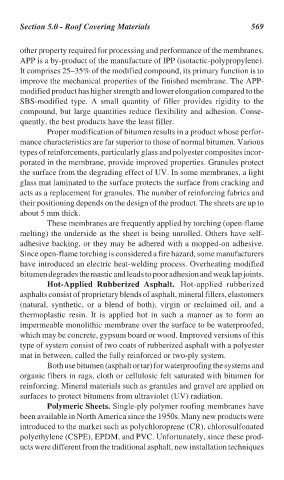Page 602 - Handbook of Thermal Analysis of Construction Materials
P. 602
Section 5.0 - Roof Covering Materials 569
other property required for processing and performance of the membranes.
APP is a by-product of the manufacture of IPP (isotactic-polypropylene).
It comprises 25–35% of the modified compound, its primary function is to
improve the mechanical properties of the finished membrane. The APP-
modified product has higher strength and lower elongation compared to the
SBS-modified type. A small quantity of filler provides rigidity to the
compound, but large quantities reduce flexibility and adhesion. Conse-
quently, the best products have the least filler.
Proper modification of bitumen results in a product whose perfor-
mance characteristics are far superior to those of normal bitumen. Various
types of reinforcements, particularly glass and polyester composites incor-
porated in the membrane, provide improved properties. Granules protect
the surface from the degrading effect of UV. In some membranes, a light
glass mat laminated to the surface protects the surface from cracking and
acts as a replacement for granules. The number of reinforcing fabrics and
their positioning depends on the design of the product. The sheets are up to
about 5 mm thick.
These membranes are frequently applied by torching (open-flame
melting) the underside as the sheet is being unrolled. Others have self-
adhesive backing, or they may be adhered with a mopped-on adhesive.
Since open-flame torching is considered a fire hazard, some manufacturers
have introduced an electric heat-welding process. Overheating modified
bitumen degrades the mastic and leads to poor adhesion and weak lap joints.
Hot-Applied Rubberized Asphalt. Hot-applied rubberized
asphalts consist of proprietary blends of asphalt, mineral fillers, elastomers
(natural, synthetic, or a blend of both), virgin or reclaimed oil, and a
thermoplastic resin. It is applied hot in such a manner as to form an
impermeable monolithic membrane over the surface to be waterproofed,
which may be concrete, gypsum board or wood. Improved versions of this
type of system consist of two coats of rubberized asphalt with a polyester
mat in between, called the fully reinforced or two-ply system.
Both use bitumen (asphalt or tar) for waterproofing the systems and
organic fibers in rags, cloth or cellulosic felt saturated with bitumen for
reinforcing. Mineral materials such as granules and gravel are applied on
surfaces to protect bitumens from ultraviolet (UV) radiation.
Polymeric Sheets. Single-ply polymer roofing membranes have
been available in North America since the 1950s. Many new products were
introduced to the market such as polychloroprene (CR), chlorosulfonated
polyethylene (CSPE), EPDM, and PVC. Unfortunately, since these prod-
ucts were different from the traditional asphalt, new installation techniques

